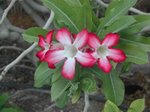
"Dedicated to Art and Free to All." This is the bold proclamation chiseled into the stone above the entrance of the St. Louis Art Museum, which sits atop Art Hill in Forest Park. Not the mantra of very many museums here in the US, but then again, not many are this grand and palatial, possessing the might to waive admission fees. This past Sunday, I wandered through the American Art rooms on the main floor. A few paintings grabbed my attention revealing my mood of the moment. I stood in front of two in particular for a while: Henry O. Tanner's "Gateway, Tangier" and Winslow Homer's "The Country School." Two very different paintings, but at the time, I thought I could fall into them, like Alice, see the inner workings of the scene, the inside shape of the brush stroke, as if it were three-dimensional. And no, I had not recently imbibed anything that had been tagged "drink me." I don't really know what that's about. I felt the same way watching the hands of Red Holloway's pianist as he took his part in the chorus of improvisation. I could fall into the sequence of notes he played. What brought me out of this was the following quotation on the wall near paintings by Asher Durand and Thomas Cole:
"The great struggle for freedom has sanctified many a spot, and many a mountain, stream, and rock has its legend worthy of a poet's pen or painter's pencil." --Thomas Cole, 1832.
So goes the rhetoric of nationalism. Some hubris, too. Politics aside, in my recent reading Cormac McCarthy and Charles Frazier have certainly painted landscapes with words in such ways one just doesn't see much of in contemporary writing.
Nothing, however, compares to the wildlife I' ve spotted here in the landscape that is the campus of Wash U. (howz that for a transition?) First, the small, brown bunnies. Ok, where do they come from? Have they so over-populated nearby Forest Park, that a few have ventured out to the frontier of the quads of campus housing? Do they have their own bunny version of Manifest Destiny? What do they do when the hordes of students come back in September? When it snows? Are there sinister traps lying in wait for them somewhere? These bunnies are not of the wily Bugs variety, but the innocent Thumper variety. I have a hard time reconciling these bunnies with the environment of the city. So too, my encounter with a mother duck with three ducklings following dutifully behind. This, my first week here, in the middle of a street on my way to dinner. A city street with four waddling ducks, holding up traffic as mother duck searched for I don't know what. Someone please tell me where they came from?
Then there are the mutant, industrial-sized prairie dogs. Big ones. In the shapes of backhoes, bulldozers, jackhammers. All over campus. Digging up big holes, leaving big mounds of dirt haphazardly, as if the green grounds of Wash U was suffering an outbreak of some virulent, pustule-creating plague. These ubiquitous big prairie dogs, sometimes wearing t-shirts, denim and hardhats, come armed with spades, shovels, picks, drill bits attached to fork-lift-like chariots. Furthermore, they plant flags every time they create a mound of dirt that satisfies them, after they have poked around wires, pipes, and sprinkler systems. They don't discriminate either between soft earth and the more resistant blocks of stone and cement. Holes everywhere, I'm telling you. No wonder I've developed the feeling I'm falling into something. Someone should call Animal Planet. Or Al Gore.

No comments:
Post a Comment